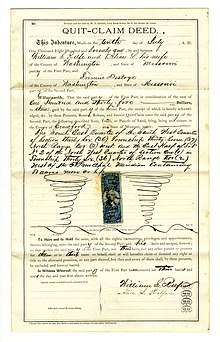Quitclaim deed
A quitclaim deed is a legal instrument that is used to transfer interest in real property. The entity transferring its interest is called the grantor, and when the quitclaim deed is properly completed and executed, it transfers any interest the grantor has in the property to a recipient, called the grantee.[1] The owner/grantor terminates (“quits”) any right and claim to the property, thereby allowing the right or claim to transfer to the recipient/grantee.
| Property law |
|---|
| Part of the common law series |
| Types |
| Acquisition |
| Estates in land |
| Conveyancing |
| Future use control |
| Nonpossessory interest |
| Related topics |
| Other common law areas |
Higher category: Law and Common law |
Overview
Unlike most other property deeds, a quitclaim deed contains no title covenant and thus offers the grantee no warranty as to the status of the property title;[2] the grantee is entitled only to whatever interest the grantor actually possesses at the time the transfer occurs.[3] This means that the grantor does not guarantee that it actually owns any interest in the property at the time of the transfer,[4] or if it does own an interest, that the title is free and clear. It is, therefore, possible for a grantee to receive no actual interest, and – because a quitclaim deed offers no warranty – have no legal recourse to recover any losses. Further, if the grantor should acquire the property at a later date, the grantee is not entitled to take possession, because the grantee can receive only the interest that the grantor held at the time the transfer occurred. In contrast, other deeds often used for real estate sales (called grant deeds or warranty deeds, depending on the jurisdiction) contain warranties from the grantor to the grantee that the title is clear or that the grantor has not placed any encumbrance against the title.
Because of this lack of warranty, quitclaim deeds are most often used to transfer property between family members, as gifts, placing personal property into a business entity (and vice versa) or in other special or unique circumstances.[3] An example use for a quitclaim deed is in divorce, whereby one spouse terminates any interest in the jointly owned marital home, thereby granting the receiving spouse full rights to the property: for example, when one spouse acquires the marital home in a divorce settlement, the other spouse could execute a quitclaim deed eliminating his or her interest in the property and transferring full claim to the other spouse, quickly and inexpensively.[5]
In some jurisdictions, quitclaim deeds are used in tax deed sales (in those cases, the term "tax deed" or "sheriff's deed" may be used to describe the actual document), where a property is sold in a public auction to recover the original homeowner’s outstanding tax debt. The auctioning body is usually the local government, which claims no interest to the property whatsoever, but is selling only to recover the unpaid taxes without extending any warranty for the property title. The purchaser then may need to initiate a quiet title action to remove any clouds to the title.
In many jurisdictions, quitclaim deeds are rarely used to transfer property from seller to buyer in a traditional property sale: the grantor and grantee have an existing relationship, or the grantor and grantee are the same person.[6] But in others, such as Massachusetts, quitclaim deeds are the norm.[7]
Execution of a quitclaim deed is relatively simple, and requires little more than both parties signing the deed and, if required in the state where it is executed, having the deed notarized, acknowledged before a notary or with a jurat signed before a notary.[1] A jurat, also known as a verification upon oath or affirmation, is a form of notarization in which the affiant appears before a notary, swears to the truth of the contents of the document, and signs the document in front of the notary.[8]
History

References
- "The Complete Guide to Quit Claim Deeds". Deeds.com Inc. Retrieved 12 February 2018.
- Black, Henry Campbell; Bryan A. Garner; Black Artemis (1999). Quitclaim deed. Black's Law Dictionary (7th ed.). West Group. p. 1126. ISBN 978-0314228642.
- Fogler, Jean (17 November 2017). "Top 5 Facts About Quitclaim Deeds". Investopedia, LLC. Retrieved 12 February 2018.
- See generally Barron's Law Dictionary, pp. 381-382 (2d ed. 1984).
- Dukeminier, Jesse; James Krier; Gregory Alexander; Michael Schill (November 22, 2017). Property (9th ed.). Aspen Publishers. p. 595, 599. ISBN 978-1454896500.
- Wilken, QC, Sean; Karim Ghaly (February 2, 2012). The Law of Waiver, Variation and Estoppel (2nd ed.). New York: Oxford University Press. pp. 303–304. ISBN 978-0199696833.
- Vetstein, Richard D. "The Anatomy of a Massachusetts Quitclaim Deed". The Massachusetts Real Estate law Blog. Retrieved 13 Jan 2017.
- "Jurat vs. Acknowledgments - Which One?". Michigan Secretary of State. Retrieved 12 February 2018.
- Wyther, William. "British Quitclaim, 1409". University of Toronto Libraries. Retrieved 26 October 2018.